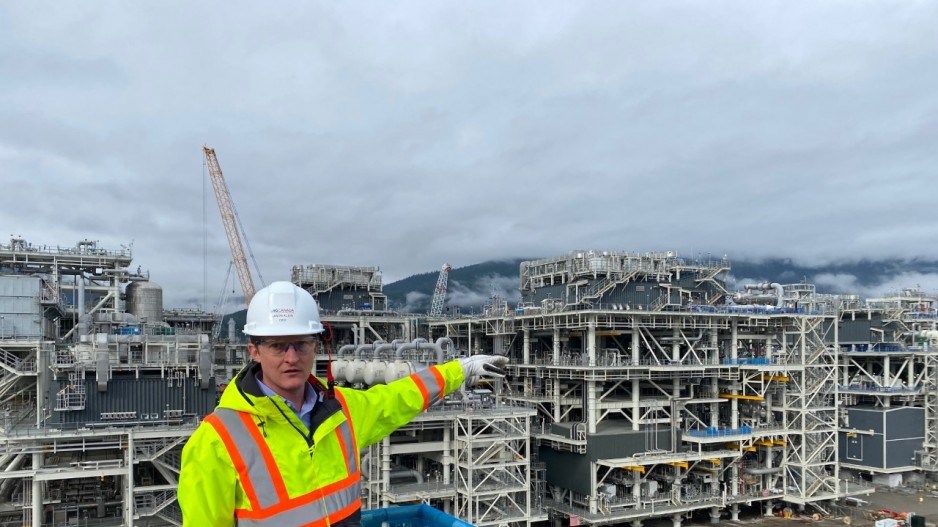The biggest private sector industrial investment in Canadian history is now in the home stretch.
A sharp drop-off in construction work can be expected next year, as the LNG Canada nears completion, unless the consortium behind the project decides to sanction a second phase expansion before the 6,000-plus workforce is sent home.
The massive natural gas liquefaction plant in Kitimat is now 85 per cent complete, the associated Coastal GasLink pipeline is 90 per cent complete, and the last of the 200 pieces of equipment (modules) needed for the massive processing complex are on their way.
“I’m pleased to say that we have completed successfully our fabrication program in China, and all of our modules have now either been installed in Kitimat or are on the water on their way to Kitimat, and the last module will arrive this month,” LNG Canada CEO Jason Klein told BIV News. “Overall, LNG Canada is now at 85 per cent complete.”
There are currently 6,500 workers employed in Kitimat, he said. Once the project is in production in 2025, it will employ 350 people ongoing.
“It’s got a 40-year lifespan, so those are really steady, long-term, well-paying jobs,” Klein said.
The LNG Canada project was estimated to be worth $40 billion – about $17 billion to $18 billion for the Kitimat plant, $6.6 billion for the associated Coastal GasLink pipeline, and the balance in upstream natural gas assets (wells, gathering systems and gas processing plants).
One component of the project has experienced some drastic cost escalations. The Coastal GasLink pipeline is now expected to cost more than $11 billion – nearly double the original estimate. Presumably, the five LNG Canada partners will have to pick up the added costs by paying higher tolls for the natural gas moving on the pipeline from Dawson Creek to Kitimat.
The project currently being built is just the first phase – a two-train plant that would produce about 14 million tonnes of liquefied natural gas per year. But it was approved for a four-train project, which would double that volume.
There are five partners in the LNG Canada project – Royal Dutch Shell, Petronas, PetroChina, Korea Gas Corporation and Mitsubishi – and they would all have to agree to sanction a Phase 2 expansion to four trains.
“With our five joint venture participants, we’re continuing to evaluate the timeline and scope for a second-phase expansion,” Klein said. “We really see an opportunity to build on Phase 1's success and benefits that’s provided to B.C. and Canada, and that includes, of course, more local jobs, more local contracts, and more infrastructure.
“Our decision on Phase 2 will take into account a number of factors: overall competitiveness, affordability, GHG intensity, and of course timelines. But we are encouraged with our discussions with government to date, and premier Eby and his government have acknowledged the benefits that further LNG can offer B.C., including reconciliation.”
LNG Canada is under pressure to electrify the plant to lower its carbon intensity. This can be accomplished by using electric motors instead of natural gas to drive turbines for the chilling process that turns natural into liquid.
That would add costs to the project. But that appears not to be the biggest obstacle. Going electric would require 400 megawatts of additional power, Klein said.
BC Hydro recently announced it will issue a new power call next year. It says it may need 3,000 megawatts of additional power as early as 2028.
But it’s not just generating capacity that’s an issue. Large industrial users like the LNG Canada plant would need beefed up transmission and substations for that amount of power, and it appears BC Hydro can’t guarantee LNG Canada that it could provide that much power and the associated infrastructure in time to make a Phase 2 build-out electric.
“We have identified the potential opportunities to further advance electrification on Phase 2, aligned with the availability of sufficient, reliable power,” Klein said. “We strongly encourage BC Hydro and the provincial government to find the pathways needed to unlock the potential of additional electric power to a number of industries and businesses in the north, including Phase 2.”
Klein said it is possible to build Phase 2 using conventional natural gas turbines, and then switch them for electric-drive when the power and infrastructure becomes available.
“What we have said is, if and when BC Hydro can provide sufficient reliable power, we would swap out those turbines for electric motors,” Klein said. “That would require BC Hydro to make new investments, particularly in transmission infrastructure, to get those electrons down to Kitimat.”
Klein will be speaking at the global LNG2023 conference Monday.



